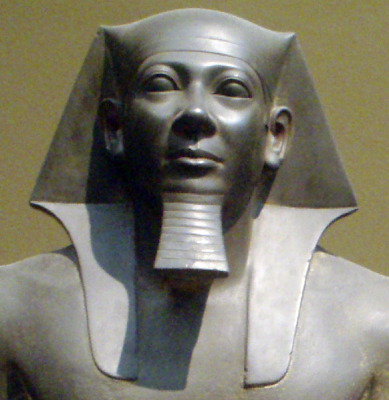Menkaure
Menkaure (or Men-Kau-Ra; Mycerinus in Latin; Μυκερινος, Mykerinos in Greek) was a pharaoh of the Fourth dynasty of Egypt (c. 2620 BC–2480 BC) who ordered the construction of the third and smallest of the Pyramids of Giza. His name means "Eternal like the Souls of Re". He was the successor of Khafra.
Some authors date his rule between 2532 BC–2503 BC or 28 years but the Turin King List has him ruling for 18 years which is the time given to him by other authors.[3] Several of his statues were unfinished upon his death—suggesting the shorter reign—while his pyramid is
the smallest of all the three royal pyramids at Giza.
Khafra
Khafra (Greek, Χεφρήν; Chephren) — also Khafre, sometimes known as Kefren — was an Egyptian pharaoh of the Fourth dynasty, who had his capital at Memphis. According to some authors he was the son and successor of Khufu, but it is more commonly accepted that Djedefre was Khufu's successor and Khafra was Djedefre's. Khafra's two chief wives were Queen Meresankh III whose mastaba tomb is located at Giza and Queen Khamaerernebty I who was the mother of his successor, Menkaura. Khafre was the builder of the second largest pyramid in the Giza Necropolis complex (his is 3 metres shorter than Khufu's). Most modern egyptologists also credit him with the building of the Great Sphinx.

Khufu
Khufu ( /ˈkuːfuː/ koo-foo), also known as Cheops ( /ˈkiːɒps/ kee-ops; Greek: Χέοψ, Kheops) or, in Manetho, Suphis ( /ˈsuːfɨs/ soo-fis; Greek: Σοῦφις, Souphis), was a Pharaoh of Ancient Egypt's Old Kingdom. He reigned from around 2589 to 2566 BC. Khufu was the second pharaoh of the Fourth Dynasty. He is generally accepted as being the builder of the Great Pyramid of Giza, one of the Seven Wonders of the Ancient World. Khufu's full name was "Khnum-Khufu" which means "the god Khnum protects me."[6]


No comments:
Post a Comment